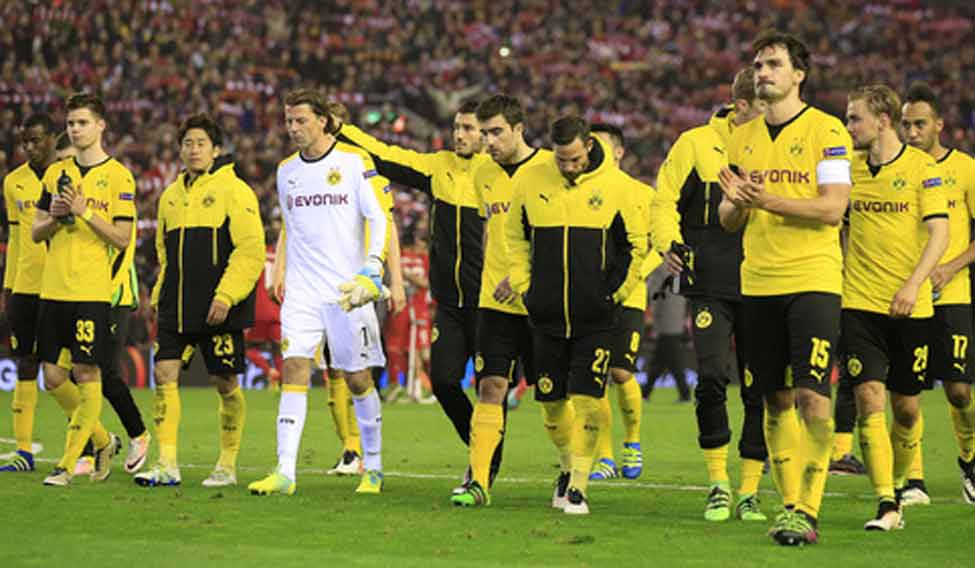Former Borussia Dortmund coach Juergen Klopp once described entering the pitch to the clamour of fans on Europe's biggest standing tribune at the club's Signal Iduna stadium as "like being born".
"You go through this dark tunnel to get on to the pitch, it's precisely two metres high," he said.
"When you come out, the place explodes... out of the darkness and into the light. You look to your left and it seems there are about 150,000 people up on the terrace all going completely nuts."
"The only difference is that, when you are born, there aren't as many people applauding."
The sight that caught the imagination of Klopp, now manager of Liverpool, was the Suedtribuene, with standing room for 25,000 fanatical, flag-waving supporters.
Standing, though, has long been banned at the World Cup, the European championship and European club competitions.
In England, all-seater stadiums became mandatory in the top two divisions following the Hillsborough disaster in 1989, when 96 fans were killed in a crush at the FA Cup semi-final between Liverpool and Nottingham Forest.
A campaign to bring back standing areas gained fresh impetus on Monday when members of the Liverpool supporters' group Spirit of Shankly (SOS) voted overwhelmingly in favour of safe standing in an online poll.
Even so, any changes to the existing legislation would require government approval as well as the backing of the football authorities. And SOS emphasised that they were not actively campaigning in favour of standing.
In countries such as Germany, Austria, Switzerland and Sweden, standing has not been banned. Instead, standing areas have been redesigned to make them safer while allowing fans to create a vibrant atmosphere.
"It's not theatre, it's football... it's important to have these emotions," said Benni Burkart, head of security at Swiss Super League club St Gallen, adding that he did not consider standing to be a risk in itself.
"The risk are the people who do not obey the rules," he told Reuters.
There are several varieties of safe standing where terraces can quickly be converted to seats for European club matches.
Rail seats are widely used in the German Bundesliga. Each row has a safety barrier which incorporates a seat that can either be locked into an upright position for standing, or unlocked and folded into position for sitting.
Other varieties include clip-on seats, where terrace steps have metal clips that seats can be attached to and removed from, and fold-away seats, which can be slipped under aluminium steps.
Like its German counterpart, Austria's Bundesliga views standing as beneficial and safe.
"We like to offer different target groups a wide range of services," the Austria league said in an e-mailed statement to Reuters.
"Those include seats, VIP offers, special offers for families in addition to standing places—which are both for the active fan scene or for spectators who simply prefer not to sit down."
"It can also be observed that the noise in the stadium as a rule emanates from the active fan scene in the standing places."
The league did not share the concept that standing fans increased the risk of vandalism.
"There are a wide range of measures to ensure the safety of spectators including wide stairs, crash barriers and security cameras," it said.
Even so, standing remains contentious.
Global soccer's governing body FIFA said it would not change its stance and all matches in its competitions, including the World Cup qualifiers, would have to take place in all-seater stadiums.
"The safety of spectators at FIFA matches is our primary concern and we are not considering any change to our position regarding appropriate spectator accommodation at FIFA matches," said a spokesperson.
In France, the National Association of Supporters (ANS) issued a 20-page booklet in November explaining why it was in favour of a return of standing areas.
"(It) would promote a greater atmosphere in the stadiums, would allow cheaper places, limit the costs of maintaining the stands and prevent supporters from injuring themselves by standing in appropriate surroundings," it said.
Spain's La Liga does not allow standing and fans seem content simply to ignore the rules—something which standing's supporters say happens elsewhere.
"One of the problems we have at the moment is that people stand up in seating areas anyway and then the people behind them are also forced to stand," said Peter Daykin from England's Football Supporters' Federation (FSF).
"It's preferable to have designated standing areas rather than having areas where some people stand and others don't. The fans deserve proper and safe standing areas."



